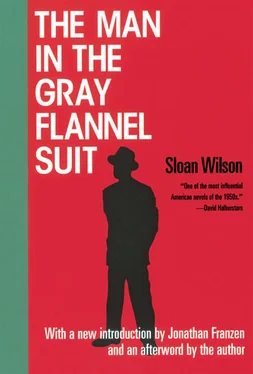The Man In The Gray Flannel Suit by Sloan Wilson
More acclaim for SLOAN WILSON’s
The Man In The Gray Flannel Suit
“Delightful. beautifully plotted.”
— Boston Herald
“[An] excellent novel.”
— Kansas City Star
“Exact in its account of the pressures, problems and tribal customs of the men in gray flannel suits. Wilson is an observer, a sympathetic one. He has written an entertaining social comedy.”
— New York Times
“Wilson has something to say.”
— Time
“Interesting and enjoyable. [Wilson] has important things to say about security, expediency, responsibility, and integrity.”
— Pittsburgh Press
“Memorable. Wilson shows a rare insight into human nature.”
— Charlotte Observer
“Wilson is an expert. His dialogue could have been piped from any of thousands of offices or living rooms. He has done more than take a trip to Brooks Brothers to find out what makes a gray flannel suit. He knows much of what makes the men who wear them.”
— Christian Science Monitor
“In his calm way, Wilson brings to the mind’s eye a man we all know, and most of us rather like.”
— San Francisco Chronicle
“A perceptive story of. the generation who came of age in World War II.”
— Miami Herald
“Brilliant. Wilson has captured the feeling of outright war and the ensuing ‘peace’ with admirable perception and veracity.”
— Vancouver Sun

Sloan Wilson was born in Norwalk, Connecticut, in 1920. At the age of eighteen he sailed a schooner from Boston to Havana. He is a graduate of Harvard, a veteran of World War II, and he has worked as a reporter for Time-Life and as a college professor. He is the author of fifteen books, including The Man in the Gray Flannel Suit and A Summer Place , both made into major motion pictures. He lives in Virginia with Betty, his wife of forty years.
Introduction by Jonathan Franzen

One of the classic settings in fiction, a little world as reassuring as imperial St. Petersburg or Victorian London, is suburban Connecticut in the 1950s. If you close your eyes, you can picture autumn leaves drifting down on quiet streets, you can see commuters in fedoras streaming off the platforms of the New Haven Line, you can hear the tinkle of the evening’s first pitcher of martinis; and hear the ugly fights then, after midnight; and smell the desperate or despairing sex.
Both the comforts and the frustrations of this little world can be found in The Man in the Gray Flannel Suit. The novel, Sloan Wilson’s first, was published in 1955. It sold extremely well and was quickly made into a movie starring Gregory Peck, but in the decades since then it has fallen out of print. Nowadays the book is remembered mainly for its title, which, along with The Lonely Crowd and The Organization Man , became a watchword of fifties conformity.
Maybe you enjoy condemning that conformity, or maybe you harbor a secret nostalgia for it; either way, The Man in the Gray Flannel Suit will provide you with a pure fifties fix. The main characters, Tom and Betsy Rath, are an attractive Wasp couple who divide their labor traditionally, Betsy staying home with three kids, Tom commuting to a fantastically bland job in Manhattan. The Raths conform, but not happily. Betsy rails against the dullness of their street; she dreams of escaping from her striving neighbors (who are, themselves, discontented); she’s anything but Supermom. When one of her daughters defaces a wall with a bottle of ink, Betsy first slaps her and then goes to bed with her; in the evening Tom finds them “tightly locked in each other’s arms,” their faces covered with ink.
Like Betsy, Tom is sympathetic in proportion to his failings. “The man in a gray flannel suit” is an object of fear and contempt for him; and yet, because his life of breadwinning and suburban domesticity feels so radically disconnected from his life as a paratrooper in the Second World War, he consciously seeks refuge in gray flannel. Applying for a lucrative new P.R. job at the United Broadcasting Corporation, he learns that the company’s president, Hopkins, plans to form a national committee on mental health. Is Tom interested in mental health?
“I certainly am!” Tom said heartily. “I’ve always been interested in mental health!” This sounded a little foolish, but he could think of nothing to rectify it.
Conformity is the drug with which Tom hopes to self-medicate for his own mental-health issues. Although he’s honest by nature, he tries hard to be a cynic. “My whole interest in life is working for mental health,” he jokes to Betsy one evening. “I care nothing for myself. I’m a dedicated human being.” When Betsy chides him for his cynicism and tells him not to work for Hopkins if he doesn’t like him, Tom replies: “I love him. I adore him. My heart is his.”
At the moral and emotional core of The Man in the Gray Flannel Suit are Tom’s four-plus years of military service. Whether he was killing enemy soldiers or falling in love with an orphaned Italian teenager, Tom Rath as a soldier felt intensely alive in the present. His war memories now form a painful contrast to a “tense and frantic” peacetime life in which, as Betsy laments, “nothing seems to be much fun any more.” Maybe Tom is unhappily traumatized by combat, or maybe, to the contrary, he’s pining for the sense of excitement and manly engagement that he lost after the war. In either case, he’s liable to Betsy’s accusation: “Since you’ve gotten back,” she says, “you haven’t really wanted much. You’ve worked hard, but at heart you’ve never been really trying.”
Tom Rath is indeed in a Consumer Age pickle. With three kids to support, he dare not venture down the road of anomie and irony and entropy, the Beat road that Kerouac blazed and Pynchon followed. But the treadmill of consumerism, the comfortable program of desiring the goods that everybody else desires, seems scarcely less dangerous. Tom can see that if he steps onto the hedonic treadmill he really will become a man in a gray flannel suit, mechanically chasing ever higher salaries in order to afford “a bigger house and a better brand of gin.” And so, in the first half of the novel, as he squirms between two equally unattractive options, his mood and his tone of voice veer wildly from weariness to rage to bravado, from cynicism to timidity to principled resolve; and Betsy, who is poignantly unaware of why her husband is unhappy, squirms and veers alongside him.
The first half of the book is by far the better half. The Raths are attractive precisely because many of their sentiments are not. And the book’s early walk-on characters, as if to mirror the Raths’ volatility, are often comic and arresting; there’s a personnel manager who reclines horizontally behind his desk, a visiting doctor who hates children, a hired housekeeper who whips the louche little Raths into shape. The first half of the book is fun. Immersing yourself in Wilson’s old-fashioned social-novel storytelling is like taking a ride in a vintage Olds; you’re surprised by its comfort and speed and handling; familiar sights seem fresh when you see them through its little windows.
Читать дальше













